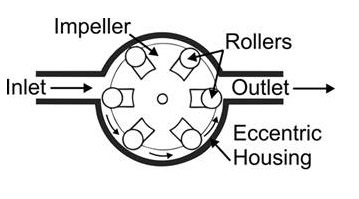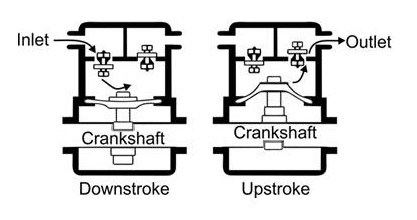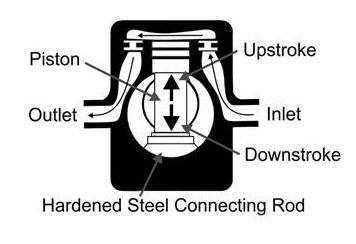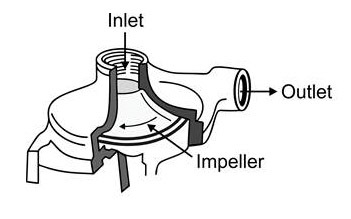Selecting a sprayer pump
Information on selecting the proper sprayer pump and hoses.
Recently, I had to rebuild a small tow-behind boom sprayer and I had questions about pumps and hoses. I turned to the HyPro-SHURflo catalog (download here) and found a very helpful guide in the few first pages. This article summarizes the steps recommended in the catalog.
Select pump style
Sprayer pumps can be divided into two categories: Positive displacement pumps and Non-positive displacement pumps.
Positive displacement pumps
These include roller, diaphragm and piston pumps. They are self-priming and traditionally operate at high pressures. Flow from these pumps is directly proportional to the pump speed, which is why they require a relief valve and bypass line between the pump outlet and the nozzle shut-off valve.
Roller pumps
This is the most popular pump with farmers world-wide. The seal and roller materials should be selected based on their compatibilities with the pesticides.
Diaphragm pumps
These compact pumps are popular for use with abrasive and corrosive pesticides. Their oil-filled piston chambers protect the pump materials.
Piston pumps
Similar to car engines, these pumps are relatively low-flow and high-pressure and suited for use with handguns sprayers. The piston cup materials should be selected based on their compatibilities with the pesticides.
Non-positive displacement pumps
These include Turbine (or Transfer) and Centrifugal pumps. They must be primed and traditionally operate at low to medium pressures, although there are models available that can go up to 190 psi. Flow from these durable pumps comes from a rotating impeller that feeds liquid through the lines instead of pumping "per stroke". Therefore, if the outlet is closed, the impeller spins harmlessly, so a relief valve is not needed.
Determine pump drive
When selecting a pump, you must specify the shaft rotation. HyPro suggests two steps for determining the required rotation:
- Eyes on the End: Face the rotating Power Take-Off (PTO) and determine if it is spinning clockwise (CW) or counter-clockwise (CCW).
- Opposites Attract: The pump must rotate opposite to the PTO. For example, if the PTO rotates CW, then the pump must rotate CCW and vice versa.
Determine pressure and flow requirements
In order to size the pump, you have to know the sprayer settings, such as intended application rate, average ground speed, agitation requirements, etc. Most can be calculated form the following formulae (provided in US Imperial and Metric):
Calculating agitation requirements
Liquids
- Tank volume (U.S. gal.) x 0.05 = Agitation requirement (gpm)
- Tank volume (L) x 0.05 = Agitation requirement (L/min.)
Wettable powders and flowables
- Tank volume (U.S. gal.) x 0.125 = Agitation requirement (gpm)
- Tank volume (L) x 0.125 = Agitation requirement (L/min.)
If the sprayer has a hydraulic agitation system equipped with a jet, it multiplies the agitation output without the need for additional flow. For example, it might have a 1 gpm input flow and boost it to a 10 gpm output. This savings should be accounted for:
- Agitation requirement (gpm) x (Input ÷ Output) = Total agitation (gpm)
- Agitation requirement (L/min.) x (Input ÷ Output) = Total agitation (L/min.)
Therefore, if you calculate a 60 gpm requirement for agitation, and have a jet that boosts the output 3:1:
- 60 gpm x (1÷3) = 20 (gpm)
Calculating Nozzle Requirements (for a Boom Sprayer)
Once the agitation requirements are accounted for, you have to account for nozzles. The calculations are a little different for each sprayer, but they amount to the same thing — Total flow in U.S. gallons per minute or litres per minute.
- Total flow requirement (gpm) = (Output (gpa) x Ground speed (mph) x Boom width (ft)) ÷ 495
- Total flow requirement (L/min.) = (Output (L/ha) x Ground speed (kph) x Boom width (m)) ÷ 600
When the flow requirement for agitation and the flow requirement for the nozzles have been calculated, they are added together. It is important not to undersize the pump, so always factor in an extra 20% to compensate for changes in performance (such as pump wear and slower ground speeds) and restrictions in the plumbing systems that can cause pressure drops between the pump and nozzles, as follows:
Agitation requirement x Nozzle requirement x 1.2 = Total flow requirement
Finally, be sure to account for any other flow requirements, such as tank rinsing nozzles and hose length/diameter (which causes pressure drops), and have some idea how you want to place the pump relative to the tractor and sprayer. If you prepare all this information, you can quickly and easily discuss your options with the retailer and select the pump that best suits your needs. For more information on sprayers, go to Sprayers 101.
Pump Illustrations based on images from the OPEP Grower Pesticide Safety Manual
Thanks to Brian Henderson, AppliTech Inc. for editorial review



